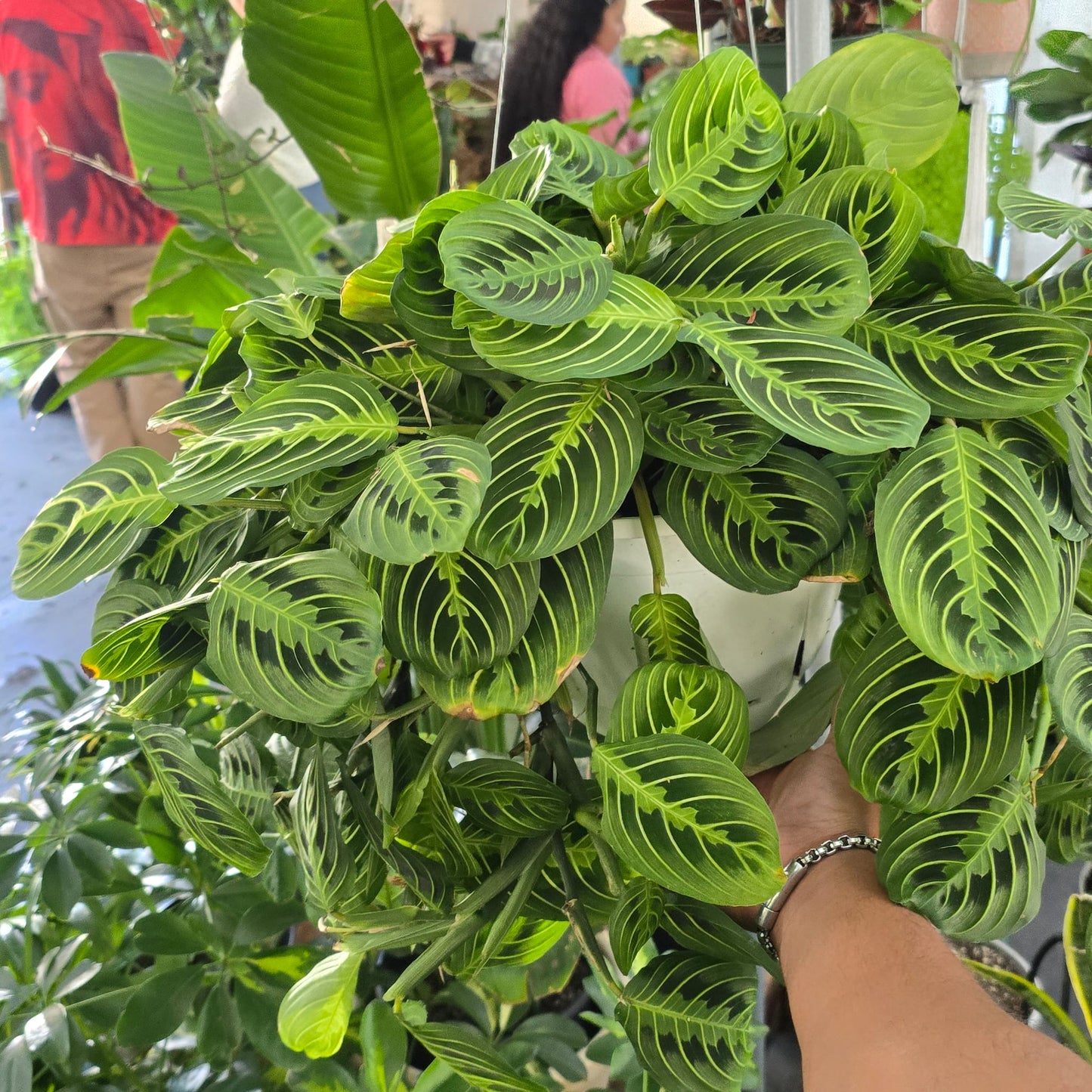Couldn't load pickup availability
Maranta leuconeura Lemon Lime indoor in 8 inch pot
Maranta leuconeura Lemon Lime indoor in 8 inch pot
The Maranta leuconeura, commonly known as the prayer plant, is a captivating houseplant prized for its beautifully patterned leaves and its fascinating nyctinastic movements – the leaves lie flat during the day and fold upwards at night, resembling praying hands. Native to the Brazilian tropical forests, this evergreen perennial belongs to the Marantaceae family.
Here's what makes the prayer plant so special and how to care for it:
Common Names:
Besides prayer plant, Maranta leuconeura is also known by several other names, including:
* Cathedral Windows
* Herringbone Plant
* Rabbit Tracks
* Red-Veined Prayer Plant
Appearance:
The prayer plant features striking, oval-shaped leaves with intricate patterns and vibrant colors. The undersides of the leaves often display a contrasting purple or gray-green hue. New leaves emerge as tightly rolled tubes.
The "Prayer" Movement:
The most distinctive feature of the Maranta leuconeura is the way its leaves fold upwards at night, a behavior called nyctinasty. This is a response to changes in light and is thought to help conserve moisture and protect the leaves.
Varieties:
Several popular varieties of Maranta leuconeura showcase a range of stunning leaf patterns and colors:
* var. erythroneura (Herringbone Plant or Red Prayer Plant): Features dark green leaves with prominent red veins.
* var. kerchoveana (Rabbit's Tracks Maranta): Displays green leaves with two rows of dark blotches.
* var. massangeana (Black Maranta): Has dark green leaves with silver blotches along the midrib and white veins.
* 'Fascinator Tricolor': Dark green leaves with light green margins, red rib veins, and a yellow center.
* 'Lemon Lime': Dark green leaves with a yellowish-green center and striping.
* 'Silver Band': Dark green leaves with a broad, silvery-green central patch.
Care Guide:
Providing the right conditions will keep your prayer plant thriving and showing off its beautiful foliage:
* Light: Prayer plants prefer medium to bright indirect light. Avoid direct sunlight, which can scorch their delicate leaves and fade their vibrant colors. They can tolerate lower light conditions, but their growth may slow, and the colors might not be as intense. An east or west-facing window with a sheer curtain is often ideal.
* Water: Water every 1-2 weeks, allowing the top inch or two of the soil to dry out between waterings. They prefer to be kept consistently moist but not waterlogged. Overwatering can lead to root rot. Prayer plants are sensitive to hard tap water, so using filtered water or rainwater is recommended to prevent brown tips on the leaves. Reduce watering during the winter months when the plant's growth naturally slows.
* Humidity: Prayer plants thrive in high humidity, mimicking their native tropical environment. Aim for humidity levels above 60%. You can increase humidity by misting the plant regularly with distilled water or rainwater, placing it on a pebble tray filled with water (making sure the pot isn't sitting directly in the water), grouping it with other humidity-loving plants, or using a humidifier. Brown, crispy leaf edges are often a sign of low humidity.
* Temperature: Maintain average room temperatures between 65°F and 85°F (18°C and 30°C). Avoid placing your prayer plant near drafts, air conditioning vents, or heat sources, as sudden temperature fluctuations can stress the plant.
* Soil: Use a well-draining, nutrient-rich potting mix. A mixture of potting soil and perlite (1:1 ratio) works well.
* Fertilizing: Feed your prayer plant every 2-4 weeks during the spring and summer growing season with a diluted balanced liquid fertilizer. Reduce or stop fertilizing during the fall and winter months.
* Repotting: Repot your prayer plant every 1-2 years, or when it outgrows its current container. Choose a pot that is only slightly larger than the previous one to avoid the soil retaining too much moisture. Spring is the best time for repotting.
* Pruning: Prune away any yellowed, brown, or damaged leaves to maintain the plant's appearance and encourage new growth. You can also trim back leggy stems to promote a bushier shape.
* Propagation: Prayer plants can be propagated by division during repotting. Simply separate the rhizomes (underground stems) into sections, ensuring each section has roots and at least one leaf, and pot them up individually. Stem cuttings can also be rooted in water or moist soil, although this method can be less reliable.
With its captivating foliage and intriguing movements, the Maranta leuconeura is a delightful addition to any indoor plant collection. By providing the right care, you can enjoy its beauty for years to come.
Get a Similar or better plant(s) than the pictures! 📷
Heatpack is included if needed, i'll check your local weather when it comes to ship it, it will also depend on the plant family. Example: Alocasias, philodendrons, monsteras.
Weather: Plant will be safely packed, even heavy 20 lb+ plants make it safe to anywhere in USA
Shipping: Handling time is from 2-6 days, transit time 1-3 days.
Quality: The picture is a sample of a good quality plant, you'll receive the same or even better!
Guarantee: Safe arrival is guaranteed, if the're any problem, please email the pictures and we'll find the best solution, replacement if the plant is heavily damaged (very rare case).
Thank you for your support!
Share


